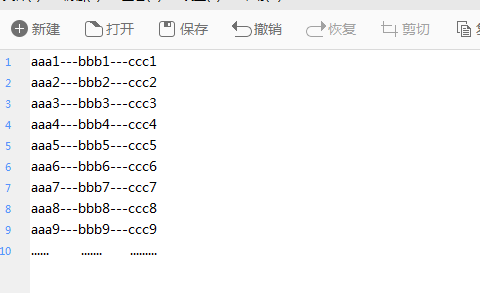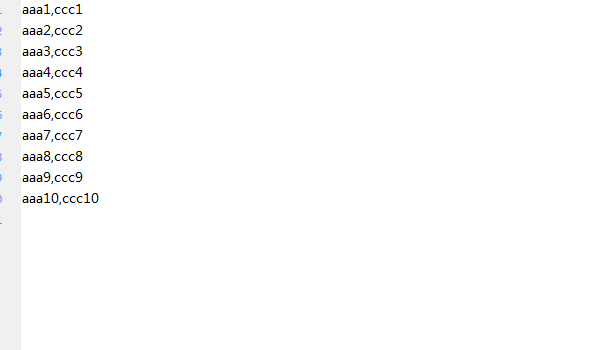【问题】需求如下:aaa1,aaa2...这一类代表的是名字,bbb1...代表是生日,ccc1....表示性别,现在需要讲aaa1...表示名字和ccc1这些表示性别的读出来,放入另一个.txt中;
读取之前数据如下 他们各个表示的类型有 --- 读取之后 读取后变为由“,”分隔,读取的.txt文本比较大如果java堆栈不够,能不能分批读取完,再写入新.txt;能不能给我一段代码。
解答:
如下的程序,将一个行数为fileLines的文本文件平均分为splitNum个小文本文件,其中换行符'r'是linux上的,windows的java换行符是'\r\n':
package kddcup2012.task2.FileSystem;
import java.io.BufferedInputStream;
import java.io.BufferedReader;
import java.io.File;
import java.io.FileInputStream;
import java.io.FileWriter;
import java.io.IOException;
import java.io.InputStreamReader;
public class FileSplit
{
public static void main(String[] args) throws IOException
{
long timer = System.currentTimeMillis();
int bufferSize = 20 * 1024 * 1024;//设读取文件的缓存为20MB
//建立缓冲文本输入流
File file = new File("/media/Data/毕业设计/kdd cup/数据/userid_profile.txt");
FileInputStream fileInputStream = new FileInputStream(file);
BufferedInputStream bufferedInputStream = new BufferedInputStream(fileInputStream);
InputStreamReader inputStreamReader = new InputStreamReader(bufferedInputStream);
BufferedReader input = new BufferedReader(inputStreamReader, bufferSize);
int splitNum = 112-1;//要分割的块数减一
int fileLines = 23669283;//输入文件的行数
long perSplitLines = fileLines / splitNum;//每个块的行数
for (int i = 0; i <= splitNum; ++i)
{
//分割
//每个块建立一个输出
FileWriter output = new FileWriter("/home/haoqiong/part" + i + ".txt");
String line = null;
//逐行读取,逐行输出
for (long lineCounter = 0; lineCounter < perSplitLines && (line = input.readLine()) != null; ++lineCounter)
{
output.append(line + "\r");
}
output.flush();
output.close();
output = null;
}
input.close();
timer = System.currentTimeMillis() - timer;
System.out.println("处理时间:" + timer);
}
} 以上程序处理大文本文件只需要30MB左右的内存空间(这和所设的读取缓冲大小有关),但是速度不是很快,在磁盘没有其他程序占用的情况下,将200MB文件分割为112份需要20秒(机器配置:Centrino2 P7450 CPU,2GB DDR3内存,Ubuntu 11.10系统,硬盘最大读写速度大约60MB/S)。
另外,对于几百兆到2GB大小的文件,使用内存映射文件的话,速度会块一些,但是内存映射由于映射的文件长度不能超过java中int类型的最大值,所以只能处理2GB以下的文件。
java 读取一个巨大的文本文件既能保证内存不溢出又能保证性能;
package helloword.helloword;
import java.io.BufferedReader;
import java.io.File;
import java.io.FileReader;
import java.io.RandomAccessFile;
import java.nio.ByteBuffer;
import java.nio.MappedByteBuffer;
import java.nio.channels.FileChannel;
public class ReadBig {
public static String fff = "C:\\mq\\read\\from.xml";
public static void main1(String[] args) throws Exception {
final int BUFFER_SIZE = 0x300000;// 缓冲区大小为3M
File f = new File(fff);
MappedByteBuffer inputBuffer = ne RandomAccessFile(f,"r").getChannel()
.map(FileChannel.MapMode.READ_ONLY, f.length() / 2, f.length() / 2);
byte[] dst = new byte[BUFFER_SIZE];// 每次读出3M的内容
long start = System.currentTimeMillis();
for (int offset = 0; offset < inputBuffer.capacity(); offset += BUFFER_SIZE) {
if (inputBuffer.capacity() - offset >= BUFFER_SIZE) {
for (int i = 0; i < BUFFER_SIZE; i++)
dst[i] = inputBuffer.get(offset + i);
} else {
for (int i = 0; i < inputBuffer.capacity() - offset; i++)
dst[i] = inputBuffer.get(offset + i);
}
int length = (inputBuffer.capacity() % BUFFER_SIZE == 0) ? BUFFER_SIZE
: inputBuffer.capacity() % BUFFER_SIZE;
System.out.println(new String(dst, 0, length));// new
// String(dst,0,length)这样可以取出缓存保存的字符串,可以对其进行操作
}
long end = System.currentTimeMillis();
System.out.println("读取文件文件一半内容花费:" + (end - start) + "毫秒");
}
public static void main2(String[] args) throws Exception {
int bufSize = 1024;
byte[] bs = new byte[bufSize];
ByteBuffer byteBuf = ByteBuffer.allocate(1024);
FileChannel channel = new RandomAccessFile(fff, "r").getChannel();
while (channel.read(byteBuf) != -1) {
int size = byteBuf.position();
byteBuf.rewind();
byteBuf.get(bs); // 把文件当字符串处理,直接打印做为一个例子。
System.out.print(new String(bs, 0, size));
byteBuf.clear();
}
}
public static void main3(String[] args) throws Exception {
BufferedReader br = new BufferedReader(new FileReader(fff));
String line = null;
while ((line = br.readLine()) != null) {
System.out.println(line);
}
}
public static void main(String[] args) throws Exception {
int bufSize = 1024;
byte[] bs = new byte[bufSize];
ByteBuffer byteBuf = ByteBuffer.allocate(1024);
FileChannel channel = new RandomAccessFile("d:\\filename", "r").getChannel();
while (channel.read(byteBuf) != -1) {
int size = byteBuf.position();
byteBuf.rewind();
byteBuf.get(bs);
// 把文件当字符串处理,直接打印做为一个例子。
System.out.print(new String(bs, 0, size));
byteBuf.clear();
}
}
}package helloword.helloword;
import java.io.BufferedInputStream;
import java.io.BufferedReader;
import java.io.File;
import java.io.FileInputStream;
import java.io.FileNotFoundException;
import java.io.FileReader;
import java.io.FileWriter;
import java.io.IOException;
import java.io.InputStreamReader;
import java.io.RandomAccessFile;
import java.util.Scanner;
public class TestPrint {
public static void main(String[] args) throws IOException {
String path = "你要读的文件的路径";
RandomAccessFile br = new RandomAccessFile(path, "rw");// 这里rw看你了。要是之都就只写r
String str = null, app = null;
int i = 0;
while ((str = br.readLine()) != null) {
i++;
app = app + str;
if (i >= 100) {// 假设读取100行
i = 0;
// 这里你先对这100行操作,然后继续读
app = null;
}
}
br.close();
}
// 当逐行读写大于2G的文本文件时推荐使用以下代码
void largeFileIO(String inputFile, String outputFile) {
try {
BufferedInputStream bis = new BufferedInputStream(new FileInputStream(new File(inputFile)));
BufferedReader in = new BufferedReader(new InputStreamReader(bis, "utf-8"), 10 * 1024 * 1024);// 10M缓存
FileWriter fw = new FileWriter(outputFile);
while (in.ready()) {
String line = in.readLine();
fw.append(line + " ");
}
in.close();
fw.flush();
fw.close();
} catch (IOException ex) {
ex.printStackTrace();
}
}
}java 读取大容量文件,内存溢出?怎么按几行读取,读取多次。 最佳答案
jdk本身就支持超大文件的读写。
网上的文章基本分为两大类:
一类是使用BufferedReader类读写超大文件;
另一类是使用RandomAccessFile类读取,经过比较,最后使用了前一种方式进行超大文件的读取,下面是相关代码,其实很简单
File file = new File(filepath);
BufferedInputStream fis = new BufferedInputStream(new FileInputStream(file));
BufferedReader reader = new BufferedReader(new InputStreamReader(fis,"utf-8"),5*1024*1024);// 用5M的缓冲读取文本文件
String line = "";
while((line = reader.readLine()) != null){
//TODO: write your business
}注意代码,在实例化BufferedReader时,增加一个分配缓存的参数即可
【题目】System是一个类,为啥不像scanner一样要创建一个对象才可以用,直接就System.out.println() ?还有new Scanner(System.in) 这个括号里可以填System.in以外的东西吗 ,不然为什么要设计这么一大串?感觉还是c++方便 cin cout 写3,4个字母就没了;
解答:
1、因为在Java 里有一个静态(static)方法的概念,且静态方法也就是类的方法,不需要创建对象 ,也就可以引用了;例如许多工具类方法为了 调用方便就定义成“静态方法“。
2、还有Java语法的特点就是冗长,所以现在JavaScript这种脚本语言或者Scala函数式的语言受到很多青睐;
3、而System.in就是一个输入流的引用而已,你可以在这里填任何输入流实例的引用来初始化Scanner。因为System.in比较特殊,而且比较常用(标准输入),因此才设置为默认值;
4、推荐 Core Java Java核心技术基础部分看看。 然后可以下载一下JDK 去阅读一下System类的源码,都是概念性的东西,比较简单

